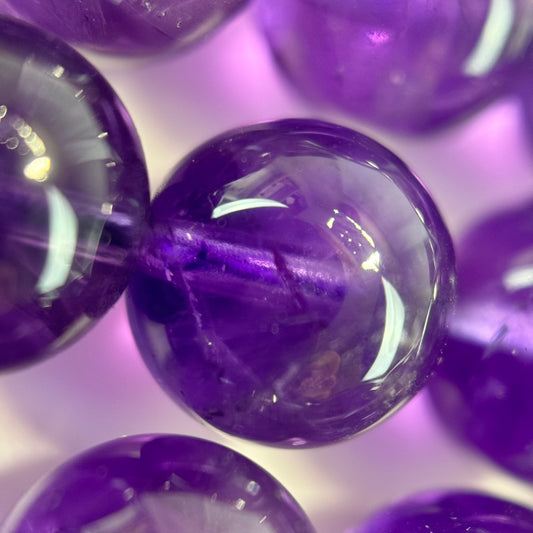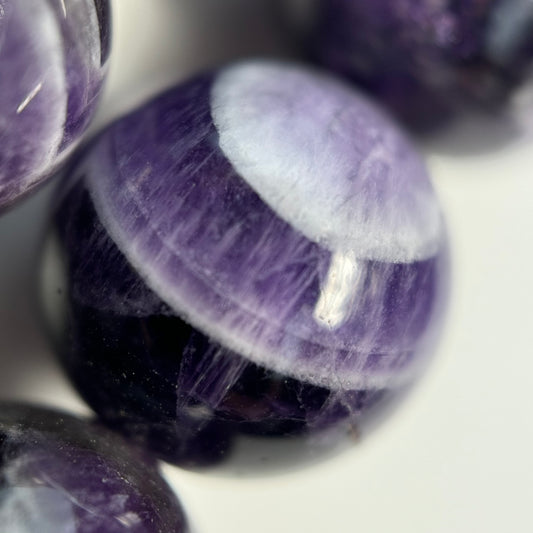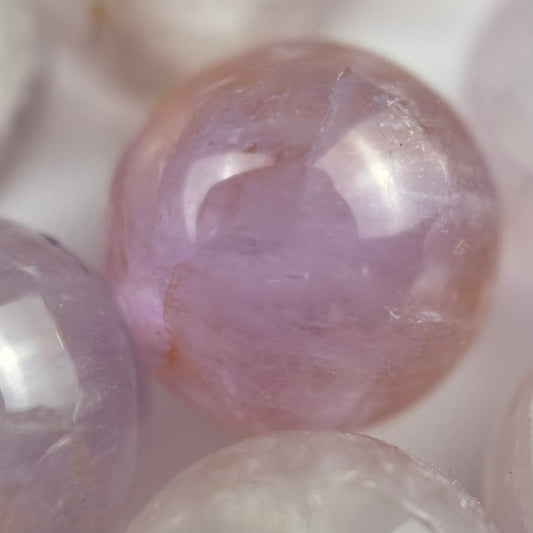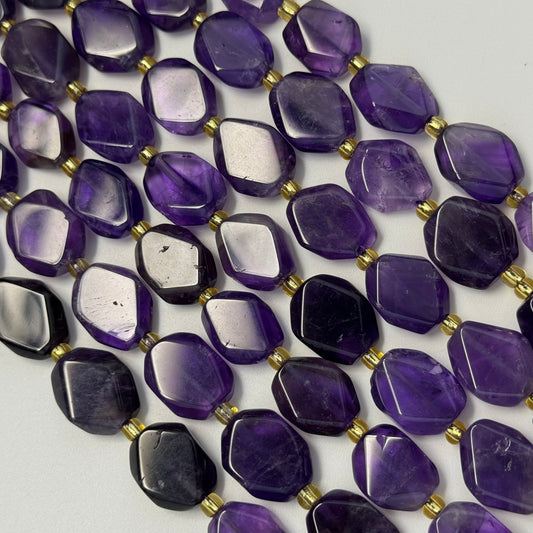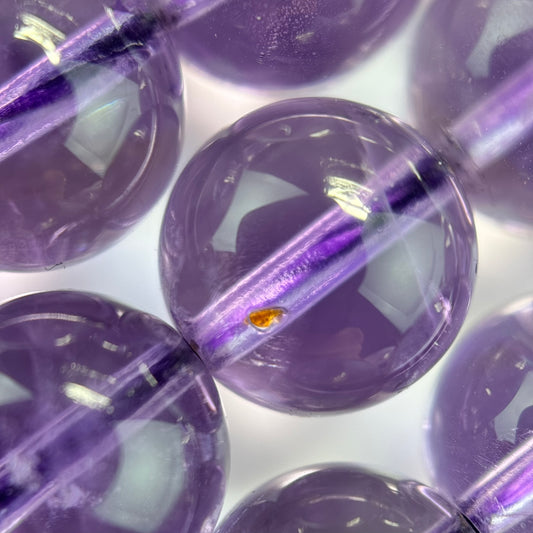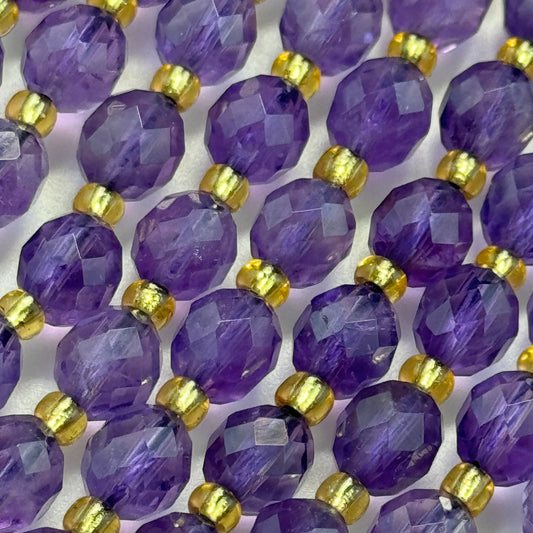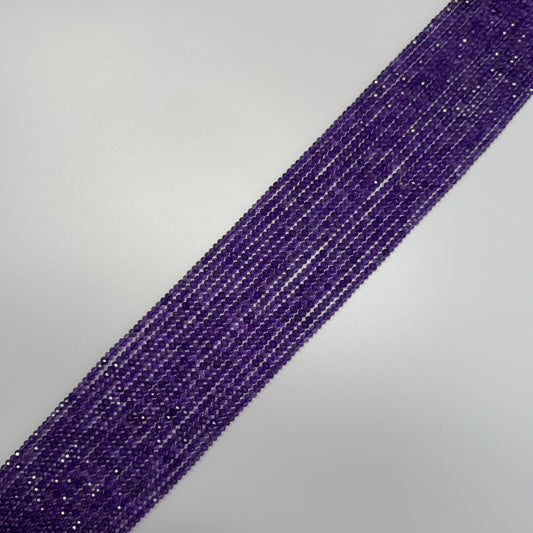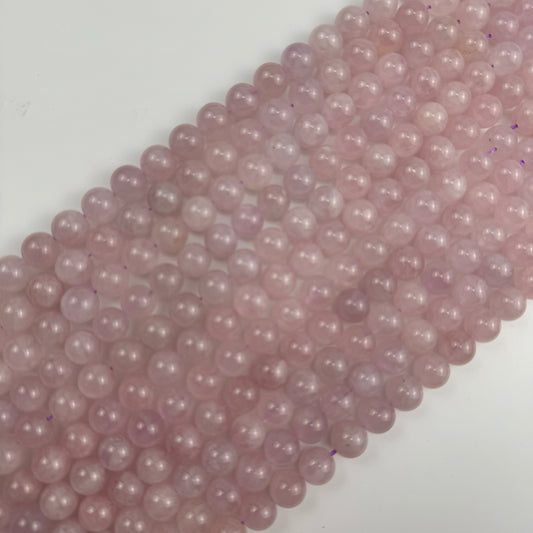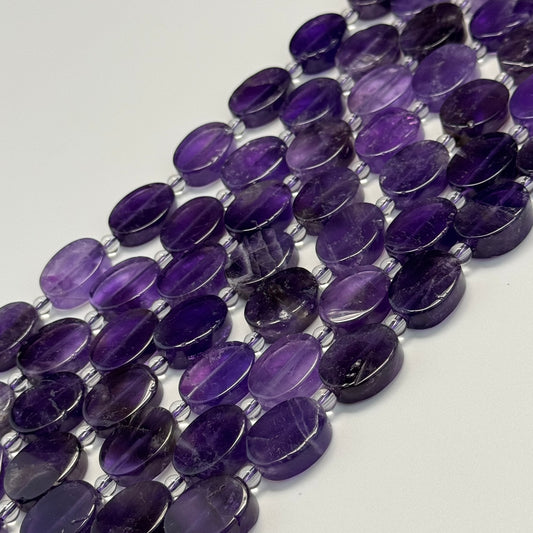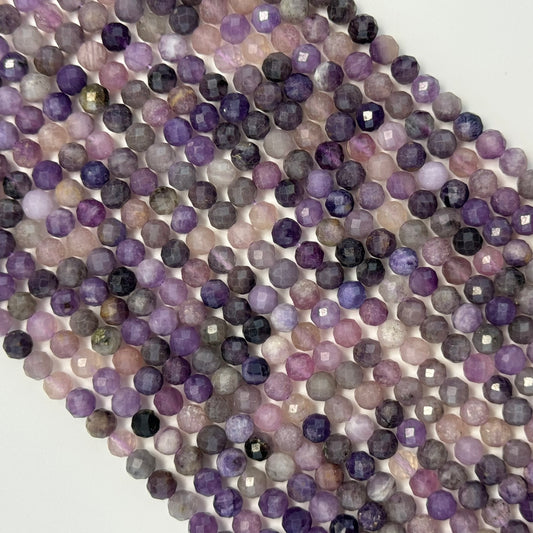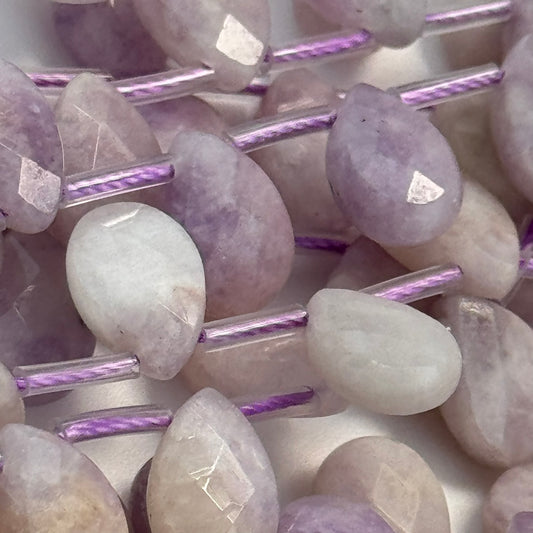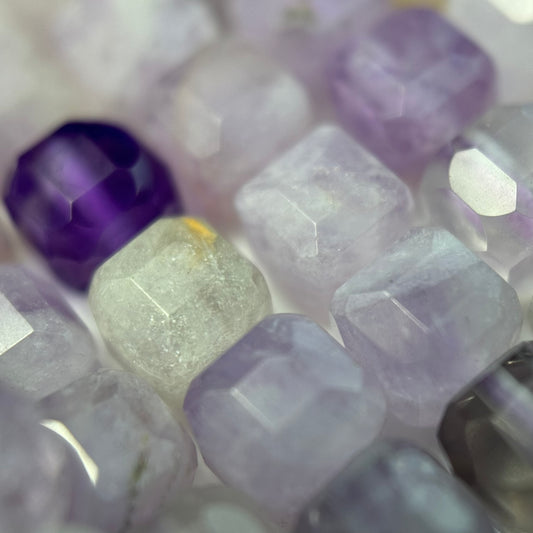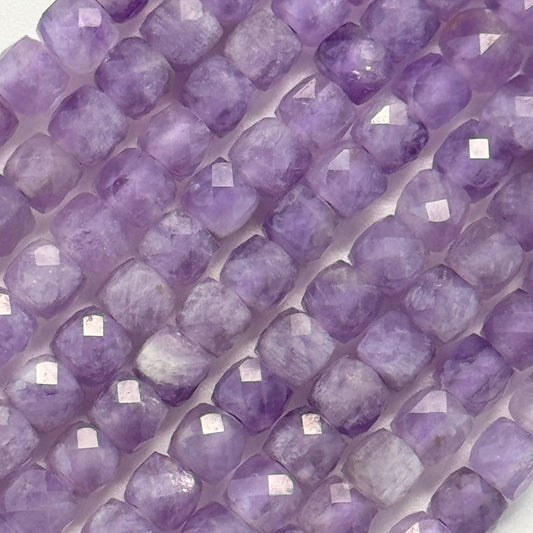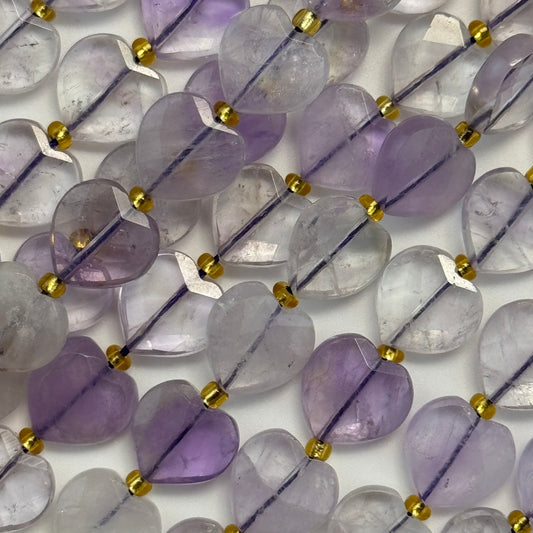Amethyst Gemstone Beads
Amethyst
Amethyst is a purple variety of quartz (SiO₂) belonging to the trigonal crystal system. Its purple color results from trace amounts of iron (Fe³⁺) impurities and natural irradiation affecting the crystal lattice. Amethyst is widely used as a gemstone due to its hardness (7 on the Mohs scale), durability, and vibrant hue ranging from pale lilac to deep violet.
Geologically, amethyst forms in geodes and volcanic rocks where silica-rich fluids crystallize under low temperatures. The color zoning and depth are influenced by the concentration and distribution of iron within the crystal. Heating amethyst above 300°C can alter its color to yellow or green, producing citrine or prasiolite.
In gemological practice, amethyst is often cut into faceted stones, cabochons, beads, or carvings. It is sourced primarily from Brazil, Uruguay, Zambia, and parts of Canada, with Brazilian amethyst known for its large crystal formations.
Types of Amethyst
Amethyst occurs in several varieties based on color zoning, inclusions, and origin. Types include Chevron Amethyst, characterized by banded purple and white patterns; Garden Amethyst, featuring unique mineral inclusions; Lavender Amethyst, known for its light lilac hue; and Natural African Amethyst, prized for its deep royal purple color with high clarity.
These types form under different geological conditions and trace element concentrations, leading to variations in hue, transparency, and crystal formation habits. They are widely used in gemology for educational classification and market differentiation.
Each type is valued for its unique visual and energetic properties, with collectors and jewelry makers selecting based on aesthetic appeal, mineral purity, and origin prestige.
Chevron Amethyst
Chevron Amethyst, also called Banded Amethyst, displays V-shaped or chevron patterns of alternating purple amethyst and white quartz layers. This banding forms due to rhythmic crystallization of silica-rich fluids during hydrothermal activity. It is used both as a decorative carving material and in metaphysical practices for amplifying clarity and inner strength.
Garden Amethyst
Garden Amethyst refers to amethyst specimens containing inclusions of other minerals such as chlorite or hematite, creating landscape-like internal formations. These inclusions occur when mineral-rich solutions infiltrate the quartz during or after its growth, resulting in scenic or moss-like visual effects within the crystal structure.
Lavender Amethyst
Lavender Amethyst is a pale lilac variety of amethyst, often containing fewer iron impurities, resulting in a softer, pastel hue. Its gentle coloration makes it highly desirable in fine jewelry for a delicate and calming aesthetic, while retaining the hardness and durability characteristic of quartz.
Natural African Amethyst
Natural African Amethyst is sourced mainly from Zambia and Namibia, known for its deep, rich purple often accompanied by flashes of blue or red under natural light. This intense coloration results from higher concentrations of iron and natural gamma irradiation within the crystal lattice, making it a premium choice for high-end jewelry pieces.
Amethyst Price
Amethyst is generally considered an affordable gemstone, with prices ranging from a few dollars per carat for light or included material to over $50 per carat for deep, saturated colors with high clarity. Factors affecting price include origin, color intensity, cut quality, size, and presence of zoning or inclusions.
African amethyst tends to command higher prices due to its vivid hue, while Brazilian amethyst is valued for large crystal formations. Rare varieties such as Chevron or Garden Amethyst with unique visual features may also attract collectors and metaphysical buyers, influencing market value.
Heat treatment is sometimes applied to enhance color, though natural untreated stones are generally more valuable among gem enthusiasts and collectors seeking authenticity and mineral integrity.
Amethyst Color (Scientific Overview)
The purple color of amethyst is due to irradiation and iron impurities (Fe³⁺) substituting for Si⁴⁺ in the quartz lattice, creating color centers that absorb specific light wavelengths. The hue can vary from pale lilac to deep violet depending on iron concentration, irradiation exposure, and structural defects within the crystal.
Spectroscopic analysis shows that the absorption bands responsible for its color occur around 545 nm and 580 nm, correlating with Fe³⁺ and electron-hole centers. Heating above 300–500°C alters these color centers, turning amethyst into yellow citrine or green prasiolite, demonstrating the thermal sensitivity of its chromophore structure.
The presence of zoning, where deeper colors appear near crystal tips or growth boundaries, reflects changes in geochemical conditions during crystal formation, aiding mineralogists in reconstructing environmental histories of quartz deposits.
Black Amethyst
Black Amethyst is a rare form of amethyst with extremely dark purple coloration, often appearing nearly black due to dense iron inclusions or hematite coatings within the crystal matrix. While still part of the quartz family, its optical properties are modified by these inclusions, reducing transparency and enhancing reflectivity under direct light.
This variety is often sourced from regions like Uruguay and Brazil and is prized for its striking appearance in geode formations, decorative carvings, and metaphysical applications, where it is believed to offer grounding and protective energies.
Scientifically, black amethyst’s coloration reveals high concentrations of iron oxides and reduced light transmission, distinguishing it from typical transparent or translucent amethyst varieties.
Amethyst Stone and Crystal
Amethyst is classified as a macrocrystalline quartz mineral, meaning its crystals are large enough to be visible to the naked eye. Its crystalline structure contributes to its vitreous luster and transparency to translucent appearance. Under polarized light, amethyst exhibits uniaxial optical properties characteristic of quartz.
This stone is frequently used in metaphysical practices due to its piezoelectric properties, where mechanical stress generates electric charge, a phenomenon also utilized in quartz watches. In crystal healing, it is valued for its structural integrity and stable energetic resonance.
Collectors and mineralogists seek pristine terminated amethyst crystals displaying well-formed hexagonal prisms with pyramidal terminations. These specimens provide insights into the growth environment and geochemical conditions during formation.
Amethyst Meaning
Historically, amethyst derives its name from the Greek word "amethystos," meaning "not intoxicated," as it was believed to prevent drunkenness. In ancient cultures, it symbolized clarity of mind, sobriety, and spiritual purity.
In metaphysical contexts, amethyst is associated with the crown chakra, promoting intuitive awareness, inner peace, and mental focus. It is often used in meditation practices to enhance spiritual connection and reduce mental clutter.
Contemporary interpretations regard amethyst as a stone of protection and emotional balance, aiding in stress reduction, sleep improvement, and fostering creativity.
Significance of Amethyst
Amethyst has been significant across civilizations for its aesthetic and spiritual properties. Ancient Egyptians carved amulets and scarabs from amethyst for protection. Medieval European soldiers wore it as a talisman against injury and to maintain focus in battle.
Scientifically, its significance lies in its geological formation, as it indicates silica-rich hydrothermal activity within volcanic environments. Gemologists value it for studying trace mineral coloration processes in quartz.
Today, amethyst continues to signify serenity, wisdom, and resilience, making it a favored gemstone in jewelry, ritual objects, and holistic healing practices.
Amethyst Birthstone
Amethyst is the birthstone for February, representing peace, sincerity, and spiritual wisdom. As a birthstone, it is gifted to convey inner strength and calming energy, making it a popular choice for personal talismans and milestone jewelry.
Its historical use as a birthstone dates back to the breastplate of Aaron described in the Book of Exodus, where it was believed to hold divine significance. Modern birthstone charts continue this tradition, associating amethyst with February-born individuals.
The purple hue of amethyst is also associated with royalty and nobility, adding prestige to its birthstone designation in contemporary jewelry markets.
Amethyst Jewelry
Amethyst is a versatile gemstone in jewelry making due to its durability, affordability, and rich color range. It is commonly set in rings, pendants, bracelets, and earrings, either as a polished cabochon or faceted stone.
In fine jewelry, amethyst is often paired with diamonds or white sapphires in sterling silver, white gold, or platinum settings to enhance its vibrant purple. Its moderate hardness ensures it withstands daily wear while retaining its luster.
Amethyst beads are also widely used in malas, spiritual bracelets, and artisan wire-wrapped designs, reflecting both aesthetic beauty and metaphysical significance.
Amethyst Ring
Amethyst rings are popular as both fashion and statement pieces. The gemstone is often cut into oval, round, or cushion shapes to maximize its color display. Due to its association with clarity and sobriety, amethyst rings are worn to promote focus and protection.
Amethyst Bracelet
Amethyst bracelets typically feature round or faceted beads strung on elastic or wire. They are used for both aesthetic adornment and energetic healing, believed to soothe stress and promote tranquility when worn daily.
Amethyst Earrings
Amethyst earrings come in various styles, from simple stud settings to elaborate chandelier designs. Their deep purple hue complements both casual and formal outfits, making them a staple in gemstone jewelry collections.
Amethyst Earrings Studs
Amethyst stud earrings are elegant and understated, showcasing the stone’s clarity and rich color in small faceted cuts. They are often set in sterling silver or gold and are ideal for daily wear due to their secure fit and versatile design.
Necklace with Amethyst
Necklaces featuring amethyst range from single stone pendants to multi-bead strands. Amethyst pendants are often cut as teardrops, points, or raw crystal clusters, highlighting its natural beauty and metaphysical resonance in jewelry making.
Frequently Asked Questions
What is Amethyst?
Amethyst is a purple variety of quartz (SiO₂) colored by irradiation and iron impurities within its crystal lattice. It ranges from pale lilac to deep violet and is widely used in jewelry and decorative carvings.
How is Amethyst formed?
Amethyst forms in geodes or cavities within volcanic rocks when silica-rich solutions deposit quartz crystals over millions of years. The purple color develops due to trace amounts of iron (Fe³⁺) and natural irradiation altering the quartz structure.
What gives Amethyst its color?
The purple color of amethyst results from Fe³⁺ impurities substituting for silicon in the crystal lattice, with gamma irradiation creating color centers that absorb specific light wavelengths, producing shades from lilac to deep violet.
What is the hardness of Amethyst?
Amethyst has a hardness of 7 on the Mohs scale, making it durable for use in rings, necklaces, and bracelets while still requiring care to avoid scratches from harder materials like sapphires or diamonds.
Is Amethyst a birthstone?
Yes, amethyst is the birthstone for February, symbolizing peace, wisdom, and spiritual protection. It is also given as a traditional gift for sixth wedding anniversaries.
What are the types of Amethyst?
Types include Chevron Amethyst (banded with quartz), Lavender Amethyst (light lilac hue), Garden Amethyst (with mineral inclusions), Natural African Amethyst (deep royal purple), and Black Amethyst (dense inclusions giving a dark appearance).
What is Chevron Amethyst?
Chevron Amethyst, or Banded Amethyst, combines amethyst and white quartz in V-shaped or chevron patterns formed by rhythmic deposition of silica-rich solutions during crystal growth in volcanic environments.
What is Garden Amethyst?
Garden Amethyst features inclusions of minerals such as chlorite or hematite within the quartz, creating scenic or moss-like internal patterns valued in metaphysical jewelry and mineral collections.
What is Lavender Amethyst?
Lavender Amethyst is a pale purple variety of amethyst with a soft, pastel hue due to lower iron concentrations. It is popular in delicate jewelry designs for its calming and subtle coloration.
What is Black Amethyst?
Black Amethyst appears almost black due to dense inclusions of iron oxides or hematite within the crystal matrix. It is sourced mainly from Brazil and Uruguay and used for decorative geodes, carvings, and grounding metaphysical work.
What is the spiritual meaning of Amethyst?
Spiritually, amethyst is believed to enhance intuition, protect against negative energies, promote sobriety, and support spiritual growth by balancing the crown chakra and connecting the wearer to higher consciousness.
How is Amethyst used in jewelry?
Amethyst is used in rings, pendants, earrings, bracelets, and beads due to its durability and rich color. It is set in both sterling silver and gold, with faceted or cabochon cuts highlighting its clarity and hue.
Can Amethyst be used in engagement rings?
Yes, amethyst is used in engagement rings as a unique alternative to diamonds, symbolizing spiritual love and wisdom. Due to its hardness, it is suitable for daily wear but should be protected from harsh impact.
How do you care for Amethyst jewelry?
Clean amethyst jewelry with mild soap and warm water, avoiding ultrasonic or steam cleaners. Store separately from harder stones to prevent scratches and keep away from prolonged sunlight, which may fade its color.
Where is Amethyst found?
Major sources include Brazil, Uruguay, Zambia, Namibia, Madagascar, and the United States. African amethyst is prized for its deep color, while Brazilian specimens are valued for large crystal formations.
What is the price of Amethyst?
Amethyst prices vary based on color intensity, clarity, size, and origin. Light or included material is inexpensive, while deep-colored African amethyst can reach over $50 per carat for premium quality stones.
What is the difference between Amethyst and Quartz?
Amethyst is a variety of quartz distinguished by its purple color from iron impurities. Chemically, it is identical to other quartz forms like citrine or clear quartz but differs in coloration and sometimes trace inclusions.
Does Amethyst fade in sunlight?
Yes, prolonged exposure to direct sunlight can fade amethyst’s purple color due to breakdown of color centers within the crystal lattice, so it is advisable to store it away from strong UV light.
Can Amethyst be treated to enhance color?
Amethyst may undergo heat treatment to enhance or change color, often resulting in yellow citrine or green prasiolite. Natural untreated amethyst is generally preferred for metaphysical and collector use.
How can you tell if Amethyst is real?
Real amethyst will feel cool to the touch, display natural zoning or inclusions under magnification, and have consistent hardness. Fake amethyst is often glass with bubbles or uneven color distribution.

